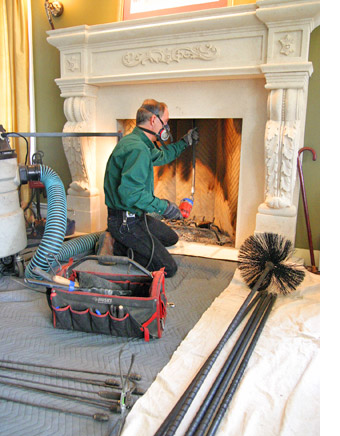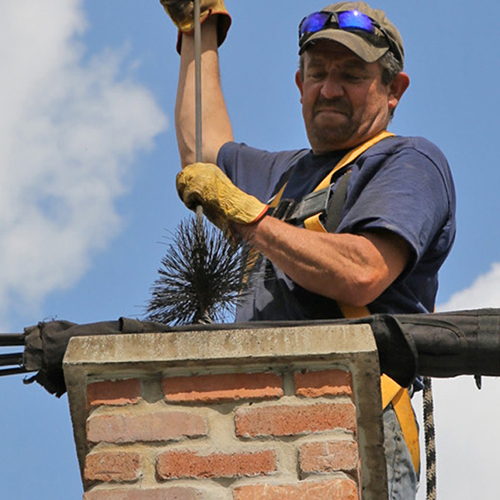Chimney Clean San Jose Quality: Making Certain a Tidy and Effective Fireplace
Chimney Clean San Jose Quality: Making Certain a Tidy and Effective Fireplace
Blog Article
Chimney Cleansing: A Step-by-Step Overview to Preserving a Healthy And Balanced Fire Place
Preserving a healthy fireplace is vital for the safety and security and effectiveness of your home. Routine smokeshaft cleansing is a crucial part of this upkeep routine. In this step-by-step guide, we will give you with in-depth instructions on exactly how to correctly clean your chimney, making sure that it operates ideally and decreases the risk of fire risks. By adhering to these guidelines, you will discover how to gather the essential devices, execute an aesthetic evaluation, clear particles and build-up, move the smokeshaft, and complete the last actions for recurring upkeep. With an expert technique and focus to information, you can confidently look after your fireplace and enjoy its warmth and convenience for years to find.
Collecting the Required Tools
To begin the procedure of smokeshaft cleaning, the initial step is to collect all the essential tools. Having the right tools available makes certain a safe and effective cleaning process. The essential devices for chimney cleansing include a chimney brush, a ladder, decrease towels or plastic sheets, a flashlight, handwear covers, and a dust mask.
The smokeshaft brush is the key device used to get rid of residue and creosote accumulation from the flue - Chimney Clean San Jose. It is important to select a brush that matches the dimension and shape of your chimney.
Ground cloth or plastic sheets are crucial for shielding the surrounding area from dirt and debris. They help include the mess and make cleaning much easier. A flashlight is crucial for evaluating the chimney's interior for any indications of damages or obstructions. Handwear covers are essential to safeguard your hands from residue and other damaging substances, while a dust mask aids protect against the inhalation of debris.
Carrying Out a Visual Assessment

Utilizing a flashlight, meticulously check out the interior walls of the smokeshaft for any kind of indicators of damage, such as cracks, loosened bricks, or mortar damage. These problems can endanger the smokeshaft's structural integrity and pose a serious safety danger. In addition, check for any type of signs of water damages, such as staining or efflorescence, as this can show a leaking smokeshaft cap or blinking.
Following, inspect the chimney flue for any kind of obstructions. Look for the visibility of nesting materials, leaves, or particles that might have accumulated over time (Chimney Clean San Jose). These obstructions can limit air flow, increase the risk of carbon monoxide buildup, and hinder the chimney's capacity to successfully air vent smoke
During the aesthetic examination, pay close attention to the smokeshaft crown, which is the top surface that protects the chimney from wetness. Search for fractures or missing out on items in the crown, as these can enable water to enter the smokeshaft and trigger considerable damage.
Clearing Particles and Accumulation
After completing the visual evaluation, the next step in smokeshaft cleansing entails clearing particles and accumulation to make sure the proper functioning of the fireplace. In time, particles such as leaves, branches, and pet nests can collect in the chimney, blocking the circulation of air and causing possible fire dangers. Additionally, the build-up of creosote, a tar-like material, is a common problem in smokeshafts. Creosote is formed when wood or nonrenewable fuel sources are burned, and otherwise removed consistently, it can result in chimney fires.
To remove debris and build-up, it is necessary to utilize the right devices and strategies. A chimney brush, especially created for this purpose, is utilized to eliminate loose debris and creosote from the chimney wall surfaces. It is vital to select a brush that matches the size of your smokeshaft to ensure efficient cleaning. Prior to starting the cleaning process, make certain to cover the fire place available to avoid particles from coming under the area.
To start, place the brush right into the chimney and move it up and down, rubbing the walls to dislodge any particles or creosote. When website here the brushing is complete, use a vacuum cleanser or a chimney brush extension to eliminate the dislodged debris from the fireplace.

Sweeping the Chimney
The sweeping of the chimney is an important action in keeping a healthy fire place. With time, residue, creosote, and other debris can build up in the chimney, blocking the circulation of air and potentially causing a dangerous buildup of combustible products. Normal smokeshaft brushing up not only makes certain correct ventilation yet additionally protects against the threat of chimney fires.
When it comes to smokeshaft sweeping, it is extremely advised to hire an expert chimney sweep. These specialists have the expertise and tools required to safely and effectively remove the accumulated debris from your smokeshaft.
It is essential to keep in mind that the regularity of chimney sweeping relies on several factors, such as the type of fuel used, the quantity of use, and the kind of chimney. As a basic general rule, it is suggested to have your chimney evaluated and brushed up at the very least annually.
Last Actions and Maintenance
After finishing the smokeshaft sweeping procedure, the very first action in the last upkeep is to evaluate the chimney cap and trigger arrestor. These parts protect against particles, pets, and rain from getting in the chimney.

Check the within of the fire place for any signs of wear and tear, such as cracks, loose bricks, or harmed mortar. These issues can influence the architectural honesty and safety of the fireplace. Speak with a professional smokeshaft move or mason to resolve them without delay. if any issues are detected.
Finally, think about installing carbon monoxide detectors near the fireplace and throughout your home. These gadgets can detect the visibility of this harmful gas, providing an early caution system in situation of a smokeshaft malfunction. Regularly check and replace the batteries in these detectors to guarantee their performance.
Final Thought
In verdict, adhering to a step-by-step overview for smokeshaft cleansing is essential in keeping a healthy fireplace. By collecting the essential tools, carrying out a visual assessment, removing particles and this hyperlink build-up, and brushing up the smokeshaft, house owners can make certain the safety and performance of their fireplace.
The important devices for chimney cleansing include a smokeshaft brush, a ladder, decrease towels or plastic sheets, a flashlight, handwear covers, and a dust mask.
A smokeshaft brush, especially designed for this function, wikipedia reference is used to eliminate loose particles and creosote from the smokeshaft wall surfaces. Normal chimney sweeping not only makes sure correct air flow however likewise avoids the threat of smokeshaft fires.
When it comes to smokeshaft sweeping, it is extremely advised to employ a professional chimney move. After finishing the chimney sweeping process, the initial step in the last upkeep is to evaluate the chimney cap and trigger arrestor.
Report this page